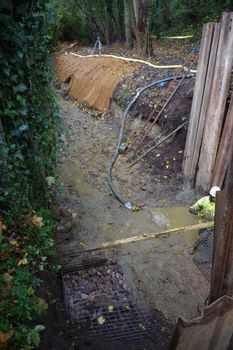Repairs to the Rollesbrook culvert in Wilton Avenue, Southampton. Archaeological Watching Brief (SOU1698)
Andy Russel, 2020. https://doi.org/10.5284/1083509. How to cite using this DOI
Data copyright © Dr Andy Russel unless otherwise stated
This work is licensed under a Creative Commons Attribution 4.0 International License.
Primary contact
Southampton City Council Archaeology Unit
18 Melbourne Street
Southampton
SO14 5FB
Tel: 023 8063 4906
Resource identifiers
- ADS Collection: 3844
- DOI:https://doi.org/10.5284/1083509
- How to cite using this DOI
Introduction

Southampton City Council Archaeology Unit carried out a watching brief on sewer and culvert repairs in Wilton Avenue between 20 November 2015 and 8 February 2016. The work was commissioned by Southampton City Council.
The conditions to observe deposits were not ideal; the site was wet and muddy and the sides of some trenches were hidden by close shuttering. The site was in the valley of the Rollesbrook and included the west end of Wilton Avenue and land to the south. The 1846 Royal Engineers map shows a footpath from Hill Lane to Bedford Place crossing the Rollesbrook stream by a bridge (or ford). The site of the bridge is now close to the garage at 115 Wilton Avenue. Groundworks exposed natural deposits, deposits of uncertain date, and 19th and 20th-century deposits.
The oldest deposit was clay with sandy lenses of the Wittering Formation. A layer of River Terrace Deposits clay and silt (known as brickearth) probably had slipped down the side of the valley. Redeposited Wittering Formation clay overlay the brickearth and contained a burnt flint and a fragment of West Country slate. Layers of clay soil contained early modern and modern concrete, bricks, pottery, and glass. No significant artifacts or features were observed but their presence may have been obscured by site conditions.





